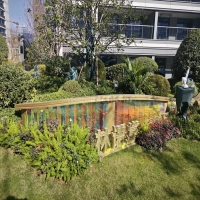Welcome to the website for landscape facilities products and knowledge.
What are the most effective ways to ventilate a landscape bar counter with cooking facilities?
Effective ventilation is crucial for landscape bar counters that incorporate cooking facilities, ensuring a comfortable environment, removing smoke and odors, and meeting health and safety regulations. The most efficient approach typically involves a combination of mechanical exhaust systems and natural airflow management.
A professionally designed and installed commercial-grade exhaust hood is the cornerstone of effective ventilation. For landscape bars, canopy-style hoods are often preferred as they capture rising heat, grease, and contaminants directly at the source. The hood should be appropriately sized to cover the entire cooking surface, and its capture velocity must be calibrated to effectively contain emissions. The extracted air then requires proper ducting to be expelled outdoors, away from public areas and intake vents. The specific requirements for CFM (Cubic Feet per Minute) ratings will vary based on the cooking equipment's BTU output and local building codes, making consultation with a mechanical engineer or HVAC specialist essential.
Supplementing the primary exhaust system, strategically placed supply air vents are necessary to replace the exhausted air. This prevents negative air pressure, which can cause drafts, make doors difficult to open, and pull undesirable air back into the space. For an open-air landscape bar, this might involve coordinating with natural breezes. In more enclosed settings, a dedicated Make-Up Air (MUA) unit that conditions incoming air is a highly effective solution for maintaining temperature control and comfort.
For settings where ductwork is impractical, such as in existing structures or island bars, ductless hoods with high-quality charcoal filters offer an alternative. While they recirculate air instead of expelling it, modern multi-stage filtration systems can effectively remove grease and neutralize odors, though they are less effective at removing heat and moisture. These systems require strict adherence to a filter maintenance schedule.
Finally, leveraging the natural environment is a key advantage of a landscape bar. Positioning the bar to take advantage of prevailing winds can help passively disperse lingering smoke and smells. Ceiling fans or specialized high-volume low-speed (HVLS) fans can further enhance air circulation, preventing stagnant air pockets and creating a more pleasant atmosphere for patrons. A successful ventilation strategy integrates a powerful mechanical exhaust, balanced air replacement, and intelligent natural airflow management.
Related search:

Recommendation
Metal and acrylic color-changing combined curtain wall for large-scale public landscape facilities